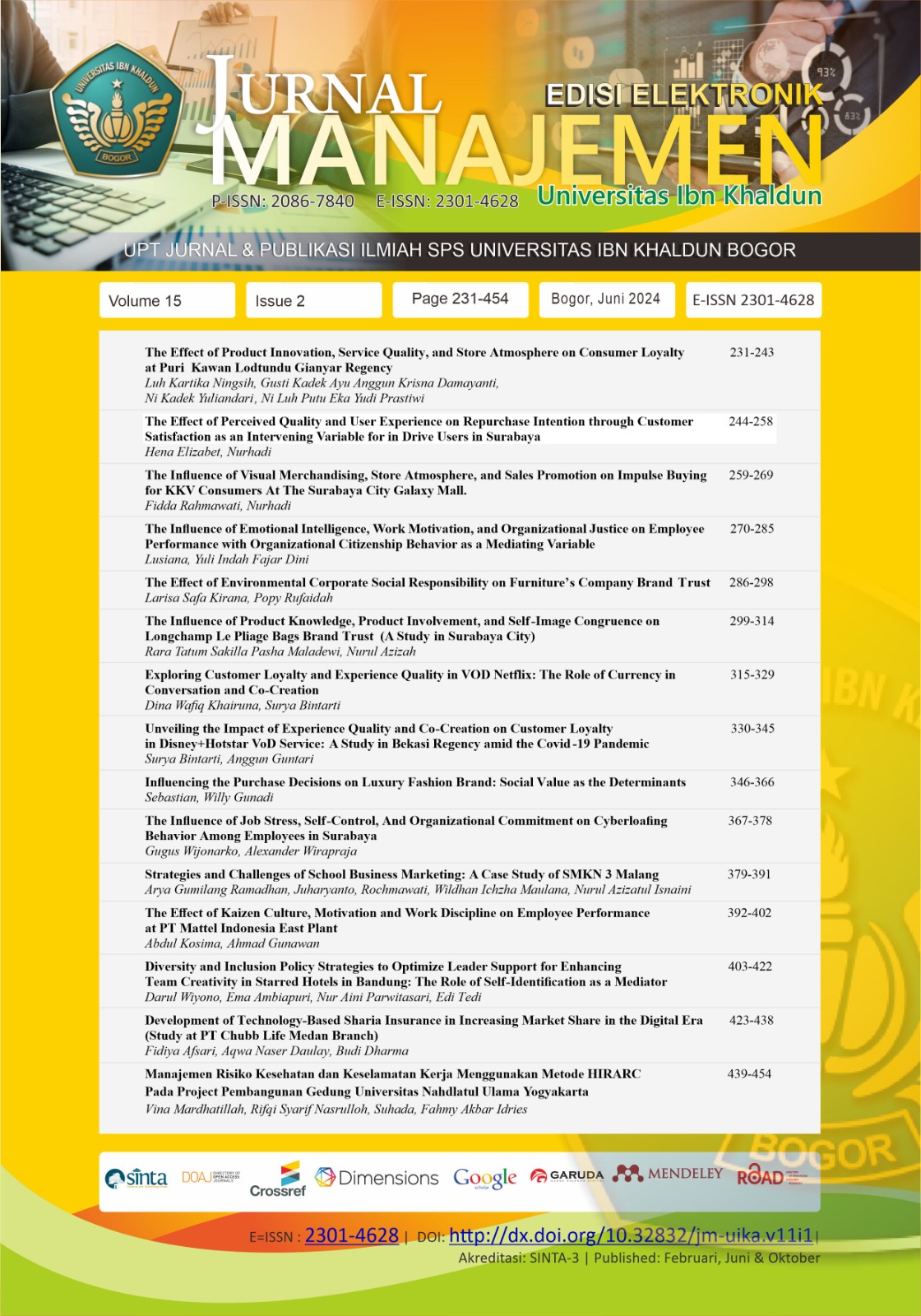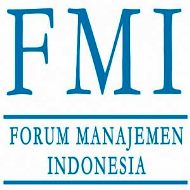Diversity and Inclusion Policy Strategies to Optimize Leader Support for Enhancing Team Creativity in Starred Hotels in Bandung: The Role of Self-Identification as a Mediator
DOI:
https://doi.org/10.32832/jm-uika.v15i2.16343Keywords:
Diversity Policy Strategy, Implementation of Inclusion Policy, Leadership Support, Self-Identification, Team CreativityAbstract
This study aims to investigate the impact of Diversity and Inclusion Policy Strategy (DIPS) on enhancing team creativity in star-rated hotels in Bandung, with self-identification as a mediator and leader support as an optimizing factor. The research methodology employed is quantitative, utilizing survey techniques and case studies, involving 339 respondents from 183 four and five-star hotels. The sample was obtained using the Slovin formula with a 0.05 margin of error, implemented through the Area Probability Sampling Technique, particularly employing a purposive sampling approach. Data were analyzed using Partial Least Squares Structural Equation Modeling (PLS-SEM) with the SmartPLS 3.0 application. The research findings indicate that DIPS has a positive and significant impact on self-identification and team creativity. Self-identification has also proven to be an effective mediator. Leader support plays an optimizing role in the relationship between DIPS and team creativity. Furthermore, specific findings regarding the impact of DIPS on self-identification and team creativity through specific pathways provide in-depth insights. The managerial implications of this research support the need for robust implementation of DIPS and effective leader support to create an innovative work environment and foster team creativity. These results can serve as guidance for management practitioners and contribute to the literature on diversity and inclusion policies, as well as team creativity in the hospitality sector
References
Amabile, T. M., & Pratt, M. G. (2016). The dynamic componential model of creativity and innovation in organizations: Making progress, making meaning. In Research in Organizational Behavior (Vol. 36). https://doi.org/10.1016/j.riob.2016.10.001
Anderson, L. (2023). Managing diversity: toward a globally inclusive workplace (fifth edition). Action Learning: Research and Practice, 20(2). https://doi.org/10.1080/14767333.2023.2218135
Asparouhov, T., & Muthén, B. (2021). Advances in Bayesian Model Fit Evaluation for Structural Equation Models. Structural Equation Modeling, 28(1). https://doi.org/10.1080/10705511.2020.1764360
Bass, Bernard M. Riggio, R. E. (2020). Transformational Leadership: Second Edition. In Lawrence Erlbaum Associates (Vol. 62, Issue 4).
Chang, Y.-Y., Chang, C.-Y., Chen, C.-W., Chen, Y. C. K., & Chang, S.-Y. (2019). Firm-level participative leadership and individual-level employee ambidexterity. Leadership & Organization Development Journal, 40(5), 561–582. https://doi.org/10.1108/LODJ-08-2018-0308
Cores-Bilbao, E., Méndez-García, M. del C., & Fonseca-Mora, M. C. (2020). University students’ representations of Europe and self-identification as Europeans: a synthesis of qualitative evidence for future policy formulation. European Journal of Futures Research, 8(1), 1. https://doi.org/10.1186/s40309-019-0159-y
Creswell John and Creswell David. (2023). Research Design, Qualitative, Quantitative and Mixed Mthod Approaches. In SAGE Publications,Inc.: Vol. Sixth Edit (Issue 1).
Davis, H. J. (2018). Servant-Leadership Decision-Making Rubric: A Greenleaf-Inspired Assessment Tool for Employee-Based Issues. International Journal of Servant-Leadership, 12(1). https://doi.org/10.33972/ijsl.73
Don-Solomon, A., & Fakidouma, P. (2021). Managing Cultural Diversity: Implication for Organizational Innovativeness. European Journal of Business and Management Research, 6(4). https://doi.org/10.24018/ejbmr.2021.6.4.1031
Downey, S. N., van der Werff, L., Thomas, K. M., & Plaut, V. C. (2015). The role of diversity practices and inclusion in promoting trust and employee engagement. Journal of Applied Social Psychology, 45(1). https://doi.org/10.1111/jasp.12273
Dubey, K., Bhargava, M., & Dinesh, N. (2023). Cultural Diversity in Organizations and Human Resource Development Programs: A Psychological Analysis. Journal for ReAttach Therapy and Developmental Diversities, 6(7).
Ely, R. J., & Thomas, D. A. (2015). Cultural Diversity at Work: The Effects of Diversity on Work Group Processes and Outcomes. The Effects of Brief Mindfulness Intervention on Acute Pain Experience: An Examination of Individual Difference, 1(2).
Fornell, C., & Larcker, D. F. (2016). Evaluating structural equation models with unobservable variables and measurement error. Journal of Marketing Research This, 18(1).
Gallarza, M. G., Arteaga, F., & Gil-Saura, I. (2015). Managers’ Perceptions of Delivered Value in the Hospitality Industry. Journal of Hospitality Marketing and Management, 24(8). https://doi.org/10.1080/19368623.2015.964898
Garcia, E., Kafle, S., Tirone, L., Sahoo, U. K., & Boichon, L. (2018). SE Technical Leadership ‐ A Model Based Framework. INCOSE International Symposium, 28(1). https://doi.org/10.1002/j.2334-5837.2018.00506.x
Hair, J. F. (2021). Partial Least (PLS-SEM) Using R Equation Modeling Squares Structural. In Structural Equation Modeling: A Multidisciplinary Journal (Vol. 30, Issue 1).
Henseler, J., Ringle, C. M., & Sarstedt, M. (2015). A new criterion for assessing discriminant validity in variance-based structural equation modeling. Journal of the Academy of Marketing Science, 43(1). https://doi.org/10.1007/s11747-014-0403-8
Heyns, M. M., McCallaghan, S., & Roos, C. E. (2021). Creative leadership and employee work wellness: Supervisor support as a mediator. Journal of Psychology in Africa, 31(1). https://doi.org/10.1080/14330237.2020.1871233
Hwang, H., Ringle, C. M., & Sarstedt, M. (2021). Guest Editorial: Special Issue on Composite-based Structural Equation Modeling: Looking Ahead. The DATA BASE for Advances in Information Systems, 7.
Jansen, W., Otten, S., Zee, K. Van Der, Amsterdam, V. U., & Jans, L. (2014). Inclusion : Conceptualization and measurement Research article Inclusion : Conceptualization and measurement. European Journal of Social Psychology, 385(June).
Kets de Vries, M. F. R., & Rook, C. (2022). The “authentizotic” organisation: creating best places to work. Organisational and Social Dynamics, 22(2). https://doi.org/10.33212/osd.v22n2.2022.220
Koh, D., Lee, K., & Joshi, K. (2019). Transformational leadership and creativity: A meta‐analytic review and identification of an integrated model. Journal of Organizational Behavior, 40(6), 625–650. https://doi.org/10.1002/job.2355
Kumar, K. (2021). Partial Least Square (PLS) Analysis. Resonance, 26(3). https://doi.org/10.1007/s12045-021-1140-1
Lauritzen, H. H., Grøn, C. H., & Kjeldsen, A. M. (2022). Leadership Matters, But So Do Co-Workers: A Study of the Relative Importance of Transformational Leadership and Team Relations for Employee Outcomes and User Satisfaction. Review of Public Personnel Administration, 42(4). https://doi.org/10.1177/0734371X211011618
Liang, T.-L., Chang, H.-F., Ko, M.-H., & Lin, C.-W. (2017). Transformational leadership and employee voices in the hospitality industry. International Journal of Contemporary Hospitality Management, 29(1), 374–392. https://doi.org/10.1108/IJCHM-07-2015-0364
Liu, H. Y., Chen, N. H., Wang, I. T., Wu, S. M., Han, C. Y., Hsu, D. Y., Han, H. M., & Huang, D. H. (2021). Predictors of individually perceived levels of team creativity for teams of nursing students in Taiwan: A cross-sectional study. Journal of Professional Nursing, 37(2). https://doi.org/10.1016/j.profnurs.2021.01.010
Martin, G. C. (2019). Managing Cultural Diversity and its Implication for Organisational Competitiveness. A Case Study. Journal of Diversity Management (JDM), 9(2).
Medina, S. (2019). HR: A Key to Diversity and Inclusion Success. Journal of Financial Planning, 32(5).
Mitchell, R., Boyle, B., Parker, V., Giles, M., Chiang, V., & Joyce, P. (2015). Managing inclusiveness and diversity in teams: How leader inclusiveness affects performance through status and team identity. Human Resource Management, 54(2). https://doi.org/10.1002/hrm.21658
Nanyangwe, C. N., Wang, H., & Cui, Z. (2021). Work and innovations: The impact of self‐identification on employee bootlegging behaviour. Creativity and Innovation Management, 30(4), 713–725. https://doi.org/10.1111/caim.12455
Nishii, L. H., & Leroy, H. L. (2020). Inclusive leadership: Leaders as architects of inclusive workgroup climates. In Inclusive Leadership: Transforming Diverse Lives, Workplaces, and Societies. https://doi.org/10.4324/9780429449673-12
Okolie, U. C., Omole, O. G., & Yakubu, A. (2021). Leadership and Effective Human Resource Management in Organization. RUDN Journal of Public Administration, 8(3). https://doi.org/10.22363/2312-8313-2021-8-3-277-296
Park, C. sik. (2023). The Relative⋅Absolute Reliability and Validityof the Toe Tap Test in Stroke Patients. Journal of Special Education & Rehabilitation Science, 62(2). https://doi.org/10.23944/jsers.2023.06.62.2.12
Pigozzi, F., Bigard, X., Steinacker, J., Wolfarth, B., Badtieva, V., Schneider, C., Swart, J., Bilzon, J. L. J., Constantinou, D., Dohi, M., Di Luigi, L., Fossati, C., Bachl, N., Li, G., Papadopoulou, T., Casasco, M., Janse van Rensburg, D. C. (Christa), Kaux, J.-F., Rozenstoka, S., … Pitsiladis, Y. P. (2022). Joint position statement of the International Federation of Sports Medicine (FIMS) and European Federation of Sports Medicine Associations (EFSMA) on the IOC framework on fairness, inclusion and non-discrimination based on gender identity and sex variations. BMJ Open Sport & Exercise Medicine, 8(1), e001273. https://doi.org/10.1136/bmjsem-2021-001273
Pitariu, H., & Budean, A. (2020). LANDY, F.J. & CONTE, J.M. (2007). Work in the 21st Century. An Introduction to Industrial and Organizational Psychology. Malden: Blackwell Publishing. Psihologia Resurselor Umane, 5(2). https://doi.org/10.24837/pru.v5i2.336
Poordanjani, H. J. M., Ghani, A. K. H., Moosharaf, N., Zadeh, M. E., Sedigeh, A., & Ghpoor, E. C. (2015). Creativity and innovation in organization. Advances in Environmental Biology, 9(2), 600–610. https://doi.org/10.4324/9780203732427
Richard, O. C., Del Carmen Triana, M., & Li, M. (2021). The effects of racial diversity congruence between upper management and lower management on firm productivity. Academy of Management Journal, 64(5). https://doi.org/10.5465/AMJ.2019.0468
Ringle, C., Hult, G. T. H., & Sarstedt, M. (2022). A primer on partial least squares structural equation modeling (PLS-SEM). In Sage.
Sekaran, U., & Bougie, R. (2016). Research Methods for Business: A Skill-Building Approach. 7th Edition, Wiley & Sons, West Sussex. In Open Access Library Journal (Vol. 5, Issue 10).
Starr-Glass, D. (2017). Workforce Diversity in Small- and Medium-Sized Enterprises: Is Social Identification Stronger Than the Business Case Argument? In Managing Organizational Diversity (pp. 95–117). Springer International Publishing. https://doi.org/10.1007/978-3-319-54925-5_5
Tarique, I., Briscoe, D. R., & Schuler, R. S. (2022). International Human Resource Management: Policies and Practices for Multinational Enterprises, Sixth edition. In International Human Resource Management: Policies and Practices for Multinational Enterprises, Sixth edition. https://doi.org/10.4324/9780429441462
Vu, N. H., Nguyen, T. T., & Nguyen, H. T. H. (2021). Linking Intrinsic Motivation to Employee Creativity: The Role of Empowering Leadership. Journal of Asian Finance, Economics and Business, 8(3). https://doi.org/10.13106/jafeb.2021.vol8.no3.0595
Walia, S., & Malik, R. (2015). Workforce Diversity Management: Essence of Modern Organisations. CPJ GLOBAL REVIEW, 7(1).
Webb, A. (2022). BOOK REVIEW: Review of Book Reviews. The Journal of Retirement, 9(3). https://doi.org/10.3905/jor.2021.1.100
Wisse, B., & Knippenberg, B. Van. (2016). Leader Self-Sacrifice and Leadership Effectiveness: The Moderating Role of Leader Leader Self-Sacrifice and Leadership Effectiveness: The Moderating Role of Leader Prototypicality. The Journal of Applied Psychology, 90(February 2005).
Yavgildina, Z. M., Batyrshina, G. I., Kamalova, I. F., Salakhova, R. I., & Salakhov, R. F. (2019). Pedagogical conditions for the creative self-actualization of future art teachers. International Journal of Civil Engineering and Technology, 10(2).
Downloads
Published
How to Cite
Issue
Section
License
Copyright (c) 2024 Jurnal Manajemen (Edisi Elektronik)

This work is licensed under a Creative Commons Attribution-NonCommercial 4.0 International License.
Authors who publish with this journal agree to the following terms:
- Authors retain copyright and grant the journal right of first publication with the work simultaneously licensed under a Creative Commons Attribution-NonCommercial-ShareAlike 4.0 International License that allows others to share the work with an acknowledgement of the work's authorship and initial publication in this journal.
- Authors can enter into separate, additional contractual arrangements for the non-exclusive distribution of the journal's published version of the work (e.g., post it to an institutional repository or publish it in a book), with an acknowledgement of its initial publication in this journal.
- Authors are permitted and encouraged to post their work online (e.g., in institutional repositories or on their website) prior to and during the submission process, as it can lead to productive exchanges, as well as earlier and greater citation of published work (See The Effect of Open Access).











